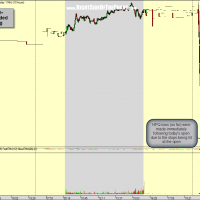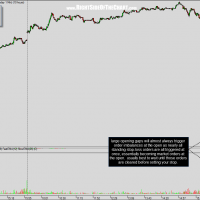Here’s a one-minute period chart showing the gap down on HPQ and the subsequent low (so far) that was put in shortly after the open. As is often the case, large gaps down produce order imbalances at the open as sell orders overwhelm buy orders and vice versa on large gaps up. These order imbalances are typically evidenced by the extremely large volume spikes seen at the open. Therefore, my logic for pulling any standing GTC stop-loss orders when I wake up to see that one of my positions will be caught on the wrong side of a gap that has exceeded my predetermined stop on the trade is that I basically have two viable options:
1) Stop out at the open and guarantee a loss on the trade, although that will also assure no additional losses.
2) Wait a couple of minutes for the opening order imbalances to clear and then place my stop below the low of the day. This strategy is likely to produce one of two outcomes; A) The gap was an over-reaction and the stock recovers some, possibly all of it’s losses either that day or over time, allowing me to close the position at a much smaller loss or possible even a breakeven or gain on the trade later on. -or- B) The stock continues lower on the day, stopping me out essentially at or slightly below where any standing stop-loss order would have been hit immediately following the open regardless. Keep in mind that there is a third possible outcome (C) and that would be that the stock bounces that day only to experience another large gap down soon, thereby further increasing your losses. However, although possible, that outcome is far less likely than A & B.



